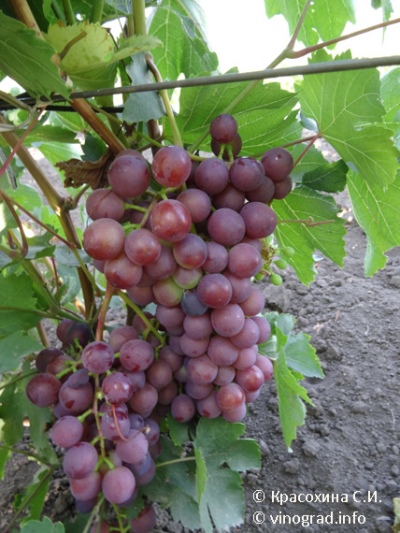
- Authors: Pavlovsky Evgeny Georgievich
- Appointment: dining room
- Berry color: dark red
- Taste: nutmeg
- Ripening period: very early
- Ripening period, days: 100-110
- Frost resistance, ° C: -24
- Bunch weight, g: 500-1000
- Flower type: bisexual
- Peeling: No
The Senya grape variety was bred relatively recently, because its properties have not been studied very well. However, the novelty has already proven itself and is in good demand among gardeners.
Breeding history
The creator of the Senya variety is the breeder Evgeny Georgievich Pavlovsky. The variety was the result of crossing the Talisman and XV11-10-26 grapes.
Description
This is a table variety, which is mainly consumed fresh, but it may well be used in cooking for preparations, pies, and drinks.
Ripening period
The variety belongs to very early varieties: the first berries can be eaten within 100-110 days.
Bunches
The bunch is dense, heavy, its weight is 500-1000 g, there are no peas.
Berries
The fruits are large, dark red in color, the skin is of medium density. The shape of the berries is round, and their weight is about 7-10 g.
Taste
Senya has a crispy flesh and a pleasant taste that can be appreciated by lovers of nutmeg varieties. Also, the berries are characterized by a light floral aroma.
Yield
The productivity of the variety depends on the conditions proposed by the gardener. For example, when placing a plot in the north and east, the bush will react poorly to low temperatures, the shoots will begin to ripen poorly, as a result of which the yield will significantly decrease. To get the best yield possible, place the plot on the south or southwest side.


Growing features
When keeping this variety on the site, pay attention to the following factors.
- You should be careful when choosing a place for landing. If a site is selected on a slope, then place the seedling in the middle or upper part, since below the windy masses and frost can have a detrimental effect on the young bush. The variety loves the sun, so the place should be well lit.
- The type of soil is of great importance. The roots of this grape variety are capable of sprouting 8-10 m deep and spreading 4-6 m wide. The plant will develop well in black soil, but if the groundwater is located above 2.5 m, then drainage should be provided.
- If the bush is planted in the spring, then this should be done not earlier than April in order to definitely avoid sudden frosts. When planting in autumn, it is worth waiting for the leaves to completely fall off and do not forget to reliably wrap the plant for the winter.
Landing
The planting process itself is as follows:
- dig a hole measuring 70x70x70 cm;
- pour soil with added manure or compost on the bottom in a layer of 15 cm;
- add a small amount of mineral dressing on top and sprinkle with simple soil;
- compact the soil and leave the hole like this for a couple of weeks;
- the day before planting, place the young shoot in a container with water and a growth stimulator;
- plant the sprout in the hole up to the root collar and carefully dig in;
- water the seedling with two buckets of water and add mulch around it to retain moisture.

Pollination
Senya has bisexual flowers containing both pistils and stamens. This means no other bushes or insects are required for pollination. The vines ripen well, often bear fruit. Propagation by cuttings is also possible - most cuttings take root.
Pruning
In the spring, the traditional removal of branches damaged during the winter is carried out. When pruning in autumn, it is recommended to leave a supply of vines in order to keep the branches from frost and give them the opportunity to develop. This is especially true for regions with cold winters.



Frost resistance and the need for shelter
The presented variety is able to withstand temperatures up to -24 degrees. If the bush is kept in the southern regions, then you can leave it in the same form for the winter. When grown in the central and northern regions, it is recommended to construct a shelter during the colder months. This can be done from metal arcs and a plastic film stretched over them.

Diseases and pests
Senya is characterized by high resistance to ailments and insects. Even such "grape" parasites as mildew, oidium and gray rot often remain indifferent to this variety.

If a grape is exposed to any disease or insect, this always affects its appearance.
Storage
The bunches of the presented variety are distinguished by their density, which provides them with good transportability and keeping quality. The fruit is characterized by a skin of medium density, which means that the berries in a separate form do not differ in a long shelf life. If a cellar is chosen for storage, then lay the bunches in such a way that part of them does not go beyond the sides of the container.











































































